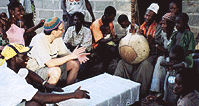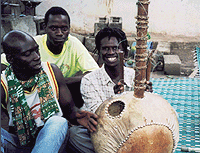 The kora has received increasing global exposure in the past decade. The 90s witnessed a flood of commercial recordings from across the Mande cultural area (ie., Senegal, Gambia, Mali, Guinea, Guinea-Bissau, and to a lesser extent, Ivory Coast and Burkina Faso) of the kora in various contexts: traditional, solo, fusion, pop, "world music" and experimental. The immense success and stunning virtuosity of Toumani Diabate, and more recently Ballake Sissoko, has currently focussed attention on the Malian tradition. While a great variety of styles and local repertoires exist among the Mande, most musicians recognize the Gambia as the historical heartland of the kora. Indeed the first kora players to make a substantial impact outside of Africa were the Gambian jalis (Mande bards) Bai Konte, Nyama Suso, Amadu Basang Jobarteh, and Foday Musa Suso.
The kora has received increasing global exposure in the past decade. The 90s witnessed a flood of commercial recordings from across the Mande cultural area (ie., Senegal, Gambia, Mali, Guinea, Guinea-Bissau, and to a lesser extent, Ivory Coast and Burkina Faso) of the kora in various contexts: traditional, solo, fusion, pop, "world music" and experimental. The immense success and stunning virtuosity of Toumani Diabate, and more recently Ballake Sissoko, has currently focussed attention on the Malian tradition. While a great variety of styles and local repertoires exist among the Mande, most musicians recognize the Gambia as the historical heartland of the kora. Indeed the first kora players to make a substantial impact outside of Africa were the Gambian jalis (Mande bards) Bai Konte, Nyama Suso, Amadu Basang Jobarteh, and Foday Musa Suso.
Amidst the diversity of styles, the practice of accompanying solo kora with the Mandinka kutiro drums (a set of three instruments, played with stick and hand) is little known. The pairing of the classical jaliya instrument and the socially low-brow (but artistically sophisticated) kutiro seems to have been a natural outgrowth of celebrations—particularly weddings—where both jalis and drummers were engaged to entertain separately but began to interact spontaneously. The texture and polyrhythms of kora music and drumming are similar and drummers listening to kora while waiting for the dancing portion of the event to begin would find it irresistible to tap out an accompaniment.
In my earliest encounter with the kora/kutiro ensemble around Serrekunda in 1987, the drumming was sparse and understated—essentially reinforcing the groove at particular points and adding occasional decorations; rhythmic propulsion was largely implied. This spacious style is somewhat similar to that used to accompany the seruba songs during a dance session. The present recording contrasts this practice by featuring Lamin Camara as a solo drummer playing the kutirindingo and kutiroba (small and large goblet-shaped drums which are usually played by two musicians) in the manner of congas or the bugarubu drums of the Jola people, and is rhythmically more dense, active and prominent in the "mix" of the ensemble. This latter feature reflects the tendency of recent Gambian kora players to make their music more danceable, no doubt influenced by popular genres, integrations of the kora into large, often electric, ensembles, and the concomitant shift of audience expectations at the performances from the traditional context of the kora as "listening" or "head" music. These features are an extension of the yeyengo style of kora playing pioneered in Casmance by players such as Kasau Kuyate in the 1970s.
 The title of this CD, Nganalu, means "great people" and celebrates those who have done great deeds and made important contributions to Mande culture throughout history. Praising individuals for both immediate concerns and for posterity shows the maintenance of traditional jali values among these young artists. The Jobartehs—Jalibakary (a.k.a. Baboucar), Sheriffo and Lamin—are sons of the highly-respected late jali Alhaji Jobarteh of Latrikunda Mampatakota, a suburb of Serrekunda. Alhaji is warmly remembered for his verbal skills, sense of humour and highly personalized style of kora playing, of which Jalibakary’s playing on this CD is a continuation.
The title of this CD, Nganalu, means "great people" and celebrates those who have done great deeds and made important contributions to Mande culture throughout history. Praising individuals for both immediate concerns and for posterity shows the maintenance of traditional jali values among these young artists. The Jobartehs—Jalibakary (a.k.a. Baboucar), Sheriffo and Lamin—are sons of the highly-respected late jali Alhaji Jobarteh of Latrikunda Mampatakota, a suburb of Serrekunda. Alhaji is warmly remembered for his verbal skills, sense of humour and highly personalized style of kora playing, of which Jalibakary’s playing on this CD is a continuation.
Of the many changes that have occurred in the Gambia over the past two decades, the rapid growth of the tourist industry has greatly affected the context of performing jaliya. While private gatherings among the Mandinka community for naming ceremonies, weddings, and the like used to provide the main venue for performances, the younger generation is more dependent on one-night engagements at hotels for a largely European audience. The arrangements for pieces have become tighter and shorter than the extended, freewheeling performances that characterize private gatherings. Jali ensembles now feature group names to accommodate this Westernized performance context. The Jobarteh’s ensemble name, Mande Cultural Group, reflects their traditional values of jaliya embodying and expressing a wide range of cultural facets that go beyond mere entertainment.

The repertoire chosen by the artists mixes well-known standards (tracks 1-5) with pieces representative of the local Serrekunda tradition (6-10).
- Tamba is a Mande standard named after Tamba Jammeh, a king remembered for his bravery.
- Bamba Bojang is a very well-known standard that laments the death of Alhaji Bojang, a popular trader from Brikama in the late 19th-early 20th century.
- Massane Cisse was a great trader of the early 20th century who died before consummating his marriage.
- Balankula is dedicated to the Sanne and Manneh families and often used to celebrate any brave person; it speaks of bravery and personal integrity, keeping one’s word.
- Yamaya is a more recent song in the lively danceable style of Gambian kora playing.
- Karabuliye jaiteh is dedicated to a great marabout (traditional healer/seer) whose faith in Allah brought him much success.
- Lana Kanutuya is dedicated to a man who is remembered for his trustworthiness and sense of love and compassion for all.
- Mama Saho is dedicated to a woman who fought for the people’s rights in Gambia.
- Tambina Yarejan, a favourite song of Alhaji Jobarteh, expresses greetings to people in Sierre Leone.

